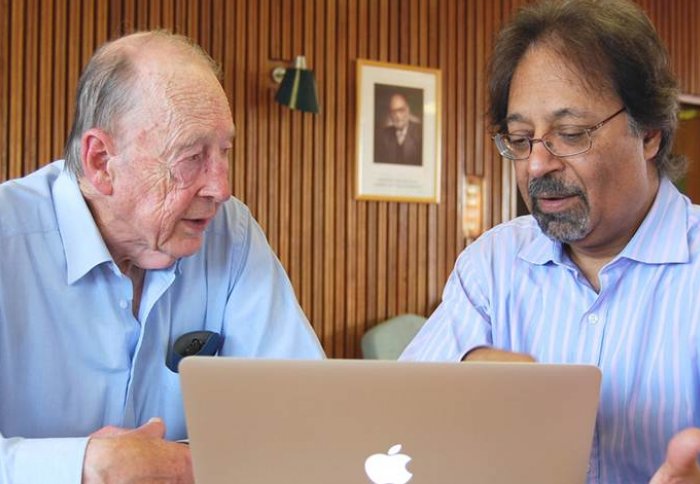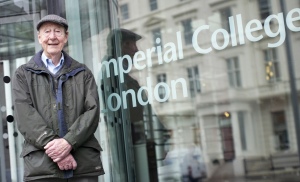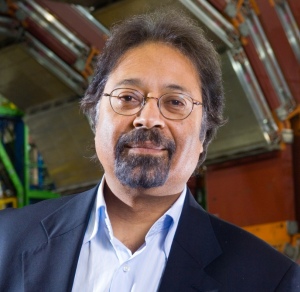Eminent physicists receive royal honours

Two of Imperial's physicists, best known for predicting and finding the Higgs boson, have been knighted in this year's Queen's Birthday honours list.
Emeritus Professor Sir Tom Kibble, whose work led to the prediction of the mass-giving particle, and Professor Sir Tejinder (Jim) Virdee, who led on the design and construction of one the detectors that found the Higgs boson, have been recognised in the Queen’s Birthday Honours list. Both scientists are from the Department of Physics at Imperial College London.

Emeritus Professor Sir Tom Kibble
The Birthday Honours are bestowed by the Queen as part of the celebration of her official birthday. A total of nine Imperial alumni were recognised in the annual honours, including Philip Dilley - a member of Imperial’s Council and former Chairman of Arup Group - who received a Knighthood (see sidebar for full details of alumni recognised). Captain David Peter Henson, Corps of Royal Engineers, who is also studying for his MSc in Biomedical Engineering in the Department of Bioengineering, has received an MBE.
Professor James Stirling, Provost of Imperial College London, who is also a theoretical particle physicist, said: “I am delighted to hear that two of my longstanding friends and esteemed colleagues in the field of physics have been recognised with these great honours. The immense contributions that Tom and Jim have made to physics are undeniable, but I take particular pleasure in congratulating them because I have first-hand experience from my own research of the profound influence that their visionary ideas have had. I feel privileged to have worked alongside them and I have no doubt that I am joined by the entire physics community in celebrating their richly-deserved success.”
I feel privileged to have worked alongside them and I have no doubt that I am joined by the entire physics community in celebrating their richly-deserved success.
– Professor James Stirling
Provost, Imperial College London
Professor Tom Kibble is an eminent theoretical physicist whose pioneering work in the 1960s led to the mass-giving particle theory, which has come to be known as the 'Higgs mechanism'.
Alongside contributions from Peter Higgs, François Englert, and other physicists, Professor Kibble published the third research paper in 1964 that described how elementary particles acquire mass.
Their visionary ideas led to the eventual detection of a Higgs boson particle at the Large Hadron Collider at CERN in Geneva, for which Higgs and Englert received the Nobel Prize in 2013. This prediction is one of the most important moments in scientific history.
In 2008 the paper in which Professor Kibble first theorised the existence of the Higgs boson, Global conservation laws and massless particles, was selected as one of the most important papers of the last 50 years by the leading journal Physical Review Letters.
Professor Sir Tom Kibble said: "I was very gratified by this public recognition of the work that for me has been a continual enjoyment. My children were delighted, and are all keen to attend the investiture if they possibly can. Since the announcement I have dealt with a huge stream of congratulatory emails. My only regret is that my wife, who died almost a decade ago, could not have been here to join in the celebrations, which she would have thoroughly enjoyed. An added bonus was to learn that the same honour was to be conferred on my friend and colleague Jim Virdee, whose work in designing, building and operating one of the huge detectors that found the Higgs boson I have long greatly admired."

Professor Sir Tejinder Virdee
Researchers at Imperial not only predicted the famous theory. They have also been central to the engineering of detectors built to find and verify the existence of the Higgs boson.
One of the UK’s most distinguished scientists, Professor Tejinder Virdee spearheaded the concept and design of the Compact Muon Solenoid (CMS) experiment, which is one of two of the main detectors of the Large Hadron Collider at CERN. Professor Virdee oversaw the construction of CMS and until 2010 was CERN’s lead spokesperson for the experiment.
In July 2012, results from the CMS experiment, together with another detector ATLAS, confirmed the existence of the elusive particle proving the theoretical work performed by both Professor Kibble and today's Nobel Prize-winning physicists.
Professor Virdee is an eminent innovator in the field of particle physics, but his knighthood also recognises his work campaigning for and promoting better science education in Africa and India.
Professor Virdee: “I was in my office in Geneva when I found out about the knighthood, which took me by surprise. It's really humbling and I'm truly honoured to be acknowledged in this way. Many brilliant scientists and engineers have worked tirelessly over two decades to make the discovery of a Higgs boson possible. I’ll definitely be celebrating over a glass of champagne with my family and friends.”
Article text (excluding photos or graphics) © Imperial College London.
Photos and graphics subject to third party copyright used with permission or © Imperial College London.
Reporter
Deborah Evanson
Communications Division
Colin Smith
Communications and Public Affairs